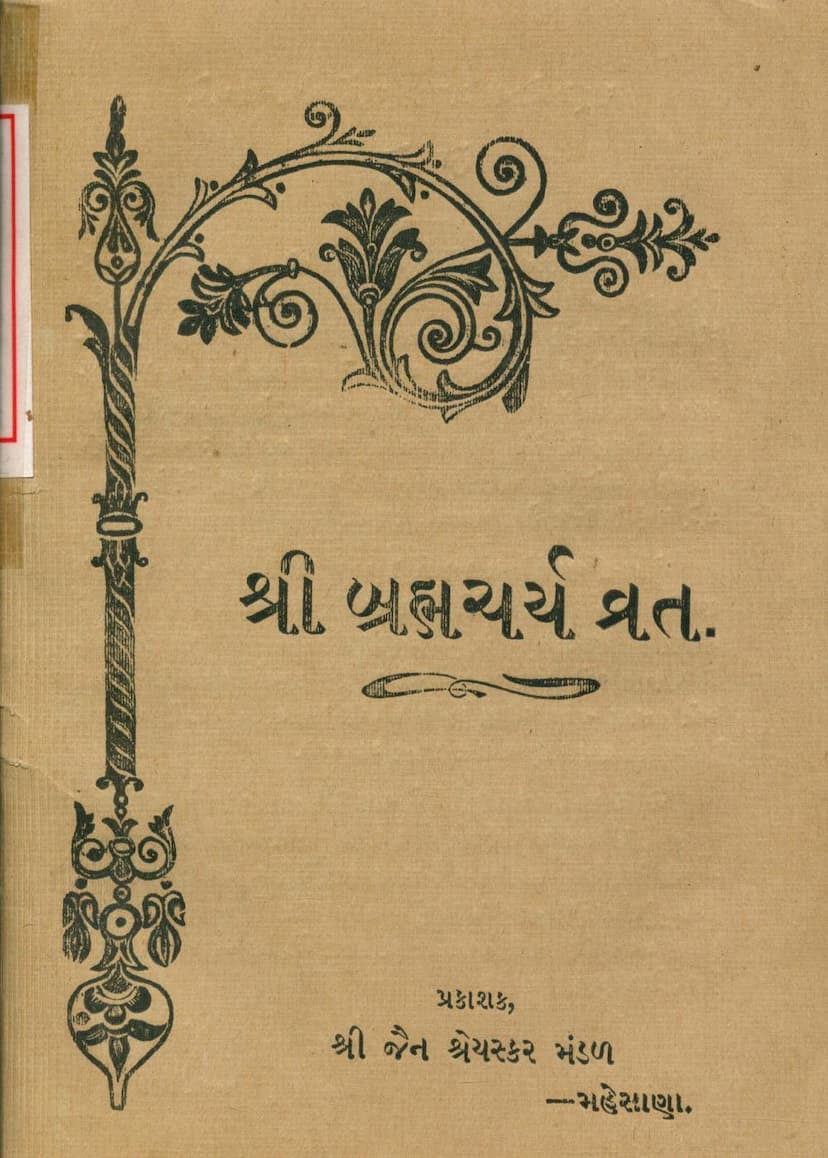Bramhacharya Vrat
Added to library: September 1, 2025

Summary
This document is a Jain text titled "Bramhacharya Vrat" (Vow of Celibacy), published by Shri Jain Shreyaskar Mandal, Mehsana. It is the sixth edition, published in Samvat 1985 (Veer Samvat 2455, Year 1929). The book is presented as a collection of inspirational teachings aimed at promoting the practice of Brahmacharya.
Here's a comprehensive summary of the key themes and content:
Core Message:
The book emphasizes Brahmacharya as the supreme vow, the foundation for spiritual, mental, and physical well-being, and crucial for the progress of individuals, society, and the nation. It attributes the decline of ancient Indian civilization to a gradual weakening of this practice and aims to revive its importance.
Structure and Content:
The book is divided into three parts:
-
Part One: The Influence and Importance of Brahmacharya
- It describes Brahmacharya as the "crown of all vows" that enhances other vows.
- It highlights Brahmacharya's role in spiritual, mental, and physical advancement.
- It attributes the strength and prosperity of past great individuals to this vow.
- It discusses the detrimental effects of neglecting Brahmacharya, leading to weakness and societal decline.
- It details the benefits of Brahmacharya, including physical health, beauty, longevity, strength, and great valor.
- It outlines the harms of sensual desires and the importance of controlling instincts.
- It provides both restrictive (prohibitive) rules for protecting Brahmacharya (e.g., avoiding provocative environments, conversations, or thoughts) and affirmative rules for its cultivation (e.g., living in pure environments, associating with virtuous people, meditating on pure forms, eating sattvic food).
- It stresses the need for careful consideration in procreation, emphasizing age-appropriateness and purity of intention for creating virtuous offspring.
- It discusses the vital need for physical and mental strength to uphold Brahmacharya and character.
- It lists various factors that lead to the breakdown of Brahmacharya, including lifestyle choices, poor upbringing, and societal influences like early marriages.
- It stresses the importance of discipline, diligence, and self-reliance in achieving one's goals, linking them to the principles of Brahmacharya.
-
Part Two: The Nature of Brahmacharya and Biographies of Virtuous Practitioners
- This extensive section focuses on the practical aspects and living examples of Brahmacharya.
- It defines Brahmacharya in its various forms: absolute (total renunciation of sensual activity) and limited (abstaining from extramarital relations).
- It further categorizes it as subtle (controlling subtle desires) and gross (abstaining from physical union).
- It details the five transgressions (Atichara) that can weaken the vow, providing detailed explanations and examples for each.
- It presents numerous biographies of Jain ascetics and lay followers who exemplified Brahmacharya, including:
- Sudarshan Sheth: His story highlights the power of virtue and chastity in overcoming temptations.
- Sthulbhadra Muni: His life demonstrates the ability to maintain spiritual discipline amidst worldly allurements and temptations, including his famous renunciation of worldly pleasures and his interactions with the courtesan Keshya.
- Sita Sati: Her story, intertwined with the epic Ramayana, emphasizes her unwavering chastity and adherence to righteousness even in dire circumstances.
- Rajimati: Her narrative, connected to Neminath, showcases her spiritual resolve and her role in guiding her husband towards renunciation.
- Anjanasundari: Her life illustrates the triumph of virtue and perseverance over immense suffering and misfortune.
- Shridevi: Mentioned in passing as a virtuous woman.
- Kalavati: Her story highlights the consequences of misunderstanding and the importance of true virtue, with a miraculous event involving a river demonstrating her purity.
- Vijay Sheth and Vijaya Rani: Their exemplary adherence to Brahmacharya, even with societal pressures and personal vows, is presented as an ideal.
- Jambukumara: His life story illustrates the journey from worldly entanglement and temptation to profound renunciation and spiritual attainment.
-
Part Three: Nine Principles of Brahmacharya and Related Teachings
- This section summarizes the "Nine Principles of Brahmacharya."
- It provides advice for virtuous women on maintaining their chastity during their husband's absence.
- It lists specific means for women to protect their chastity.
- It offers general advice for all on maintaining chastity and avoiding illicit relationships.
- It includes devotional songs (Sajhays) related to chastity and the renunciation of the fourth cardinal sin (Mithun - promiscuity/non-celibacy).
- It includes summaries of important texts, such as the "Indriya Parajay Shatak" by Muni Kavi Vijayji, which likely deals with conquering the senses.
- It concludes with a reflection on the importance of ancient characters and their role as role models.
Key Principles and Advice:
- Control of Senses: The book repeatedly stresses the need to control the five senses (sight, hearing, taste, smell, touch) and the mind.
- Diet and Lifestyle: It advocates for a simple, sattvic diet and a disciplined lifestyle, avoiding stimulating or excessive foods.
- Association: It advises against associating with people or environments that might provoke sensual thoughts or desires.
- Mindfulness: The importance of constant awareness and self-reflection is highlighted.
- Virtuous Conduct: The biographies serve as a testament to the power of virtuous conduct and the rewards, both worldly and spiritual, that come from upholding Brahmacharya.
- Self-Help and Diligence: The book promotes self-effort, diligence, and perseverance in all aspects of life, particularly in spiritual practices.
- Respect for Holy Texts: Instructions are given on how to handle the book with reverence and care.
Overall:
"Bramhacharya Vrat" is a didactic text within the Jain tradition that seeks to guide readers towards a life of celibacy and self-control. It uses scriptural teachings, biographical accounts of exemplary figures, and practical advice to illustrate the profound importance of Brahmacharya for spiritual liberation and overall well-being. The book is intended for personal and private use and aims to inspire readers to strive for higher spiritual and moral development.